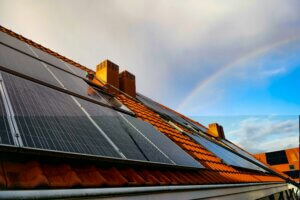
How Home Retrofits Boost Green Cities
The weather is getting hotter. The bills are getting more expensive. The solution? Retrofitting your home while there’s still time.
Not to be all doom and gloom, but the effects of a warming planet (and aging infrastructure) are only going to get more intense with time. Cities are expected to experience more frequent heat waves, floods, and blackouts, and electric bills are only going to rise.
But this is no reason for climate anxiety—there’s still time to change the course. Prioritizing sustainability in how we build and maintain our homes is no longer just about environmental responsibility, but also about survival, resilience, and cost control. No, you can’t change the entire grid overnight, but you can make smarter choices in your own space.
Why Retrofits Matter in Urban Climate Strategy
Most urban homes weren’t built with 21st-century climate realities in mind. According to the U.S. Department of Energy, residential buildings account for about 27% of the country’s energy consumption. That’s a huge chunk of emissions! But it’s also a huge opportunity.
When you retrofit your home, you’re not just lowering your electric bill. You’re reducing demand on an already strained grid, cutting fossil fuel reliance, and helping stabilize your city’s environmental footprint. Collectively, thousands of small upgrades across a metro area can have the same emissions-cutting effect as major infrastructure projects. And we don’t even have to wait for policy to catch up.
Retrofits with the Biggest Impact
Let’s skip the fluff and focus on improvements and upgrades that make the biggest difference in performance, efficiency, and long-term ROI:
- Energy-efficient windows: Old windows leak heat. Double or triple-pane replacements (especially those with low-emissivity coatings) help maintain indoor temperature without overworking your HVAC.
- Insulation: A well-insulated home is both more comfortable and efficient. Start with the attic and exterior walls. If you live in a multi-unit building, talk to your HOA or landlord about what’s possible.
- Solar panels or solar shingles: If your roof gets solid sunlight and your local net metering policies don’t penalize you, this can offset a huge chunk of your electric costs over time. And now that solar roofs are more aesthetic and modular, they’re not just for suburban rooftops.
- Air sealing: Tiny cracks and gaps around vents, windows, and baseboards can sabotage even the best insulation job. Sealing those leaks with foam, caulk, or weather stripping is a low-cost, high-impact fix.
How to Start Smart (And Actually Finish)
Most retrofits stall out before they begin, not because people don’t care, but because the process seems overwhelming. You look at the whole house, the costs, the options, and end up doing nothing. It’s understandable, but it’s also avoidable if you treat this like any other project with constraints: prioritize, phase, and fund.
Start by scheduling an energy audit. Not a quick checklist from a blog—get a proper one, ideally through your local utility (many offer rebates or free assessments). It’ll pinpoint inefficiencies you can’t see.
From there, sort improvements into stages. Focus first on what keeps conditioned air where it belongs: insulation, air sealing, and window upgrades. You don’t want to throw solar panels on a roof if your house is leaking energy at every seam, for example.
Now, paying for it. This doesn’t need to blow your savings or delay everything until “someday.” Set a phased budget across one to three years. For instance, insulate this fall, replace windows next spring, and install solar after that. Breaking things into manageable pieces helps maintain momentum and makes your goals more achievable.
When it comes to funding, look at tools designed for long-term upgrades, not short-term debt. If you have equity, a fixed-rate Home Equity Line of Credit (HELOC) is a smart option. It gives you access to funds with predictable payments, as there are no surprise spikes if interest rates shift. You can learn more about fixed rate HELOCs on Griffin Funding if you’re considering how to structure funding without overexposing your cash flow.
Also, explore local, state, and federal incentives. The DSIRE database is the go-to resource for this: simply enter your ZIP code to access a comprehensive list of programs and rebates. Depending on your location, you might get up to 30% back through the federal Residential Clean Energy Credit, or access low-interest financing tied to energy efficiency.
Wrapping Up
Retrofitting isn’t just about your own home: when enough homeowners retrofit their spaces, it changes how cities function. There’s less demand on centralized grids, fewer peak outages during summer spikes, and cleaner air in dense neighborhoods. And yes, lower emissions that help cities hit their climate targets.
This is also a quality-of-life improvement that compounds year over year. You save money, stay comfortable, and future-proof your biggest asset against extreme weather and market volatility.